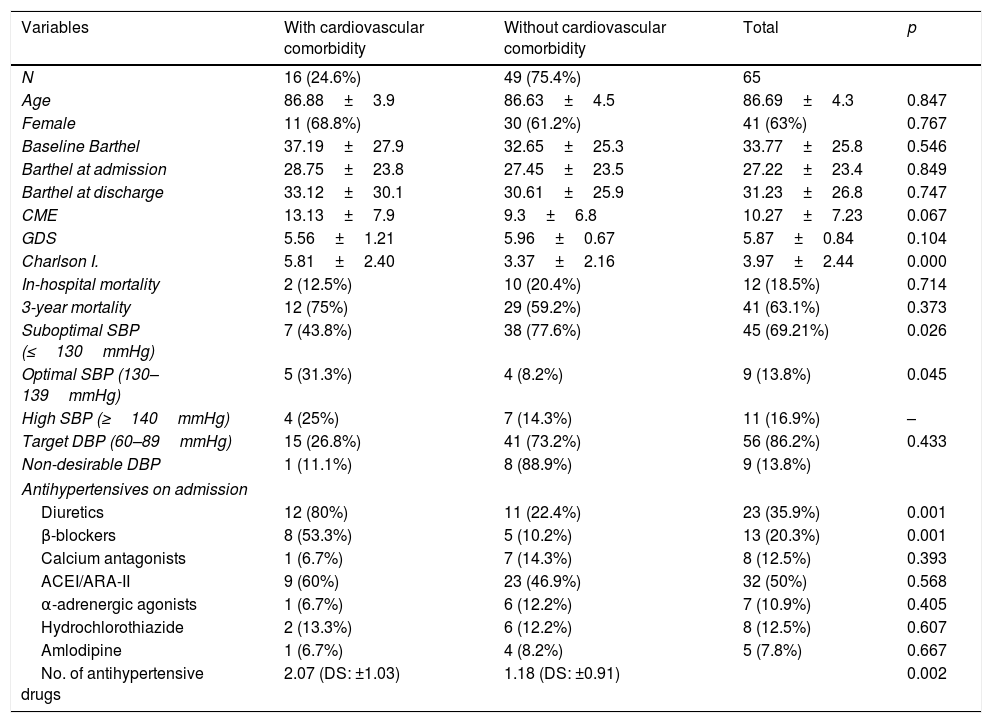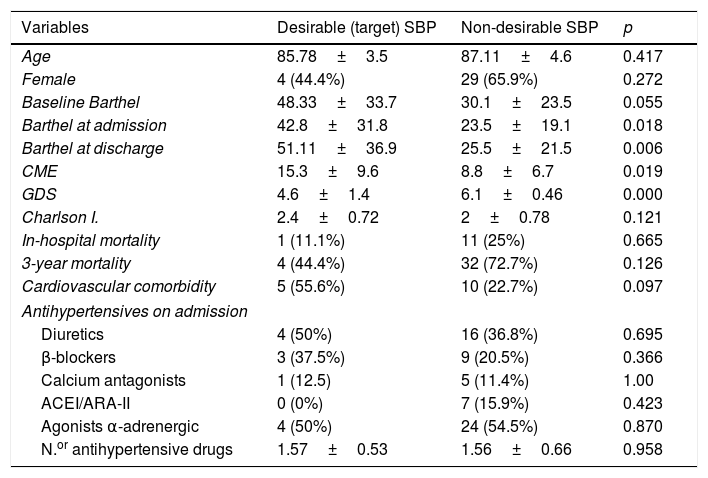To determine the control of systolic blood pressure (SBP) retrospectively according to the recommendations of the ESC/ESH-2018 guideline and its relationship with mortality in octogenarian patients with dementia.
Patients and methodsPreliminary, longitudinal, observational, retrospective study, including 65 patients ≥80 years with diagnosis of dementia and arterial hypertension admitted to a psychogeriatric unit during 2015. The main variables were SBP control according to the recommendations of the ESC/ESH-2018 guideline, considering desirable SBP (130–139mmHg), undesirable SBP (suboptimal <130mmHg and elevated SBP ≥140mmHg) and mortality at 3 years.
ResultsMean age, 86.7±4.31 years (63% women); severe functional dependence (Barthel index <40): 67.7%; severe cognitive impairment (GDS-Riesberg ≥6): 86.3%; high comorbidity: 49%; mortality at 3 years: 41 (63.1%). Patients with arterial hypertension and cardiovascular comorbidity had a higher prescription of antihypertensive drugs (2.07 vs. 1.18, p=.002). Three years mortality was lower in patients with desirable SBP (44.4%) versus undesirable SBP (72.7%) groups, although it was not statistically significant.
ConclusionsThe percentage of patients in treatment with suboptimal SBP was elevated especially in hypertensive patients without cardiovascular comorbidity. We found a trend for higher mortality in undesirable SBP groups compared to desirable SBP.
Determinar el control de la presión arterial sistólica (PAS) de forma retrospectiva según las recomendaciones de la guía ESC/ESH-2018 y su probable asociación con la mortalidad en pacientes octogenarios con demencia.
Pacientes y métodosEstudio preliminar, longitudinal, observacional y retrospectivo que incluyó 65 pacientes ≥80 años con diagnóstico de demencia e hipertensión arterial ingresados en una unidad de psicogeriatría durante 2015. Las variables principales fueron: control de la PAS según las recomendaciones de la guía ESC/ESH-2018, considerando PAS deseable (130-139mmHg), PAS no deseable (subóptima <130mmHg, elevada ≥140mmHg) y la mortalidad a 3 años en aquellos pacientes con tratamiento antihipertensivo al alta (n=53).
ResultadosEdad media, 86,7±4,31 años (63% mujeres); dependencia funcional severa (índice de Barthel <40): 67,7%; deterioro cognitivo grave (GDS-Riesberg ≥6): 86,3%; elevada comorbilidad: 49%; mortalidad a 3 años: 41 (63,1%). Los pacientes con hipertensión arterial y comorbilidad cardiovascular presentaron mayor prescripción de antihipertensivos (2,07 vs. 1,18; p=0,002). La mortalidad a 3 años fue menor en aquellos con PAS deseable (44,4%) respecto a PAS no deseable (72,7%), aunque no fue estadísticamente significativo.
ConclusionesEl porcentaje de pacientes en tratamiento con PAS subóptima fue elevado especialmente en hipertensos sin comorbilidad cardiovascular. Encontramos una tendencia a mayor mortalidad en los grupos de PAS no deseable respecto a PAS deseable.










